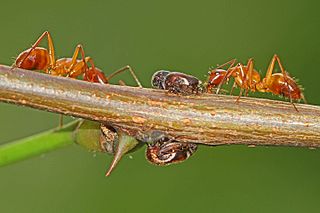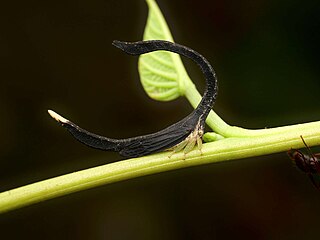
Treehoppers and thorn bugs are members of the family Membracidae, a group of insects related to the cicadas and the leafhoppers. About 3,200 species of treehoppers in over 400 genera are known. They are found on all continents except Antarctica; only five species are known from Europe. Individual treehoppers usually live for only a few months.

The buffalo treehopper is a species of treehopper belonging to the subfamily Smiliinae. It is sometimes classified as Ceresa bisonia.

Stictocephala is a genus of treehoppers in the family Membracidae; in the subfamily Smiliinae and tribe Ceresini. Species appear to be distributed mostly in North America, but S. bisonia has become widely distributed in Europe.

Enchenopa binotata is a complex of multiple species found mostly in Eastern North America, but have also been reported in Central America. They are commonly referred to as treehoppers and are sap-feeding insects. The species in the complex look similar to each other in morphology, but are identified as different species by the host plant they occupy.

Entylia carinata, commonly known as the keeled treehopper, is a species of treehopper in the family Membracidae. They can be found in Brazil, Panama, Mexico, the United States, and Canada. Keeled treehoppers are often attended by ants which feed on the honeydew they excrete. In return, the ants offer protection from predators. Keeled treehoppers typically feed on plants in the aster family and they are not known to transmit plant diseases and are not considered significant plant pests.

Microcentrus is a genus of treehoppers in the family Membracidae. There are about 10 described species in Microcentrus.

Smiliinae is a subfamily of treehoppers in the family Membracidae. These are bugs and include about 100 genera in 10 tribes.

Telamona is a genus of treehoppers in the family Membracidae. There are at least 38 described species in Telamona.

Thelia is a genus of treehoppers in the family Membracidae. There are at least two described species in Thelia.

Tylopelta is a genus of treehoppers in the family Membracidae. There are at least four described species in Tylopelta.

Vanduzea is a genus of treehoppers in the family Membracidae. There are about 12 described species in Vanduzea. The genus was named after American entomologist Edward Payson Van Duzee.

Membracinae is a subfamily of treehoppers in the family Membracidae. There are more than 40 genera in Membracinae.

Bocydium is a genus of insects in the treehopper family, Membracidae. A 1999 classification identified 14 species in the genus, distributed around the Neotropics.
Laura Sullivan-Beckers is an associate professor of evolutionary biology at Murray State University. She is credited with the discovery of Hebetica sylviae, a species of treehopper, named for her daughter Sylvie Beckers.

Enchenopa is a genus of treehoppers in the family Membracidae. There are more than 50 described species in Enchenopa.

Hebetica sylviae is a member of the treehopper family Membracidae. It is found in the eastern United States, first discovered in Murray, Kentucky, with a second sighting in Atlanta, Georgia.

Antonae is a genus of treehoppers in the family Membracidae.

Cladonota is a genus of neotropical treehoppers widespread from Mexico to South America. They are known for their elaborate pronotum shapes, hypothesized to play a role in camouflage or mate recognition, although their function is not yet known with certainty. Previously described as a subgenus of Sphongophorus, it was recognized as a genus of its own right after the latter was synonymized with Hypsauchenia.

Cladonota apicalis is a species of treehopper within the family Membracidae. The species is found distributed in Mexico, Central America, Ecuador, Bolivia, Peru, Venezuela, and Brazil. Individuals typically reach lengths of 6 to 9 millimeters. The species name was likely given after the white mark on the dorsal posterior surface.















